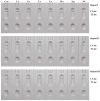Rapid and Accurate Detection of Chrysomya megacephala (Diptera: Calliphoridae) Using Recombinase Polymerase Amplification Combined with Lateral Flow Dipstick
- PMID: 39769610
- PMCID: PMC11677130
- DOI: 10.3390/insects15121008
Rapid and Accurate Detection of Chrysomya megacephala (Diptera: Calliphoridae) Using Recombinase Polymerase Amplification Combined with Lateral Flow Dipstick
Abstract
Estimating the postmortem interval (PMI) is critical in the field of forensic science, and necrophagous insects play a significant role in this process. Chrysomya megacephala (Fabricius) (Diptera: Calliphoridae) is a common necrophagous insect species, making its rapid and accurate identification essential. However, commonly used molecular biology methods, such as DNA barcode, still have some limitations in identifying necrophagous insects as they are often complex, time-consuming, and reliant on laboratory instruments. Therefore, in this study, we have developed an innovative detection system for the rapid and accurate identification of C. megacephala based on the Cytochrome b gene using recombinase polymerase amplification (RPA) and lateral flow dipstick (LFD) in combination. The developed RPA-LFD detection system achieved complete amplification in just 15 min at 37 °C with good sensitivity and specificity. Only 7.8 × 10-4 ng or more of target DNA fragments were required, and a positive detection rate of 100% was achieved in 18 C. megacephala samples from actual cases. In addition, the ability of the developed RPA-LFD detection system in combination with rapid DNA extraction methods to enable on-site detection was preliminarily explored. The results suggested that when the RPA-LFD detection system was combined with the grinding ddH2O extraction method (a rapid DNA extraction method), the process from species acquisition to visualization of detection results could be completed in less than 20 min. In conclusion, this innovative RPA-LFD detection system outperforms commonly used molecular biology methods for C. megacephala identification in terms of speed, sensitivity and convenience, making it suitable for direct application at crime scenes, promising to provide important assistance in estimating PMI and expanding the impact of forensic entomological evidence.
Keywords: Chrysomya megacephala; forensic entomology; insect species identification; lateral flow dipstick; recombinase polymerase amplification.
Conflict of interest statement
The authors declare no conflicts of interest.
Figures





Similar articles
-
Application of recombinase polymerase amplification with CRISPR/Cas12a and multienzyme isothermal rapid amplification with lateral flow dipstick assay for Bactrocera correcta.Pest Manag Sci. 2024 Jul;80(7):3317-3325. doi: 10.1002/ps.8035. Epub 2024 Mar 4. Pest Manag Sci. 2024. PMID: 38375936
-
Effect of fluctuating temperatures on the development of forensically important fly species, Chrysomya megacephala (Diptera: Calliphoridae).Forensic Sci Int. 2025 Feb;367:112373. doi: 10.1016/j.forsciint.2025.112373. Epub 2025 Jan 14. Forensic Sci Int. 2025. PMID: 39824037
-
Recombinase Polymerase Amplification Combined with Lateral Flow Dipstick Assay for the Rapid and Sensitive Detection of Pseudo-nitzschia multiseries.Int J Mol Sci. 2024 Jan 22;25(2):1350. doi: 10.3390/ijms25021350. Int J Mol Sci. 2024. PMID: 38279350 Free PMC article.
-
Rapid On-Site Detection of the Bursaphelenchus xylophilus Using Recombinase Polymerase Amplification Combined With Lateral Flow Dipstick That Eliminates Interference From Primer-Dependent Artifacts.Front Plant Sci. 2022 Mar 18;13:856109. doi: 10.3389/fpls.2022.856109. eCollection 2022. Front Plant Sci. 2022. PMID: 35371187 Free PMC article.
-
Rapid and sensitive detection method for Karlodinium veneficum by recombinase polymerase amplification coupled with lateral flow dipstick.Harmful Algae. 2019 Apr;84:1-9. doi: 10.1016/j.hal.2019.01.011. Epub 2019 Mar 14. Harmful Algae. 2019. PMID: 31128793
References
Grants and funding
LinkOut - more resources
Full Text Sources
Research Materials

